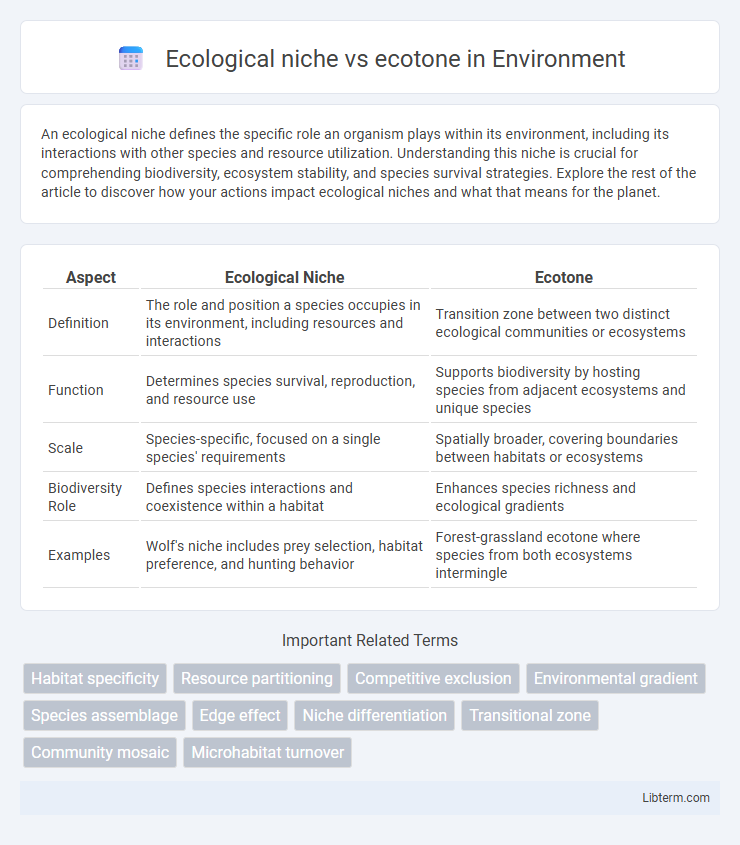An ecological niche defines the specific role an organism plays within its environment, including its interactions with other species and resource utilization. Understanding this niche is crucial for comprehending biodiversity, ecosystem stability, and species survival strategies. Explore the rest of the article to discover how your actions impact ecological niches and what that means for the planet.
Table of Comparison
| Aspect | Ecological Niche | Ecotone |
|---|---|---|
| Definition | The role and position a species occupies in its environment, including resources and interactions | Transition zone between two distinct ecological communities or ecosystems |
| Function | Determines species survival, reproduction, and resource use | Supports biodiversity by hosting species from adjacent ecosystems and unique species |
| Scale | Species-specific, focused on a single species' requirements | Spatially broader, covering boundaries between habitats or ecosystems |
| Biodiversity Role | Defines species interactions and coexistence within a habitat | Enhances species richness and ecological gradients |
| Examples | Wolf's niche includes prey selection, habitat preference, and hunting behavior | Forest-grassland ecotone where species from both ecosystems intermingle |
Defining Ecological Niche
An ecological niche defines the specific role and position a species occupies within an ecosystem, including its habitat, resource use, and interactions with other organisms. It encompasses the environmental conditions necessary for the species' survival and reproduction, highlighting its adaptive strategies and functional ecosystem role. Unlike an ecotone, which is a transitional area between two distinct ecosystems, an ecological niche focuses on the species-specific requirements and contributions within a single environment.
What is an Ecotone?
An ecotone is a transitional zone where two distinct ecological communities or ecosystems meet and integrate, characterized by a high diversity of species from both adjacent habitats. It often exhibits unique environmental conditions and species interactions not found in the neighboring ecosystems, leading to increased biological activity and complexity. Unlike an ecological niche, which refers to the role and position of a species within an ecosystem, an ecotone represents a spatial area defined by the overlap and blending of ecological boundaries.
Key Differences Between Niche and Ecotone
An ecological niche describes the role and position of a species within its environment, including its habitat, resource use, and interactions with other organisms. An ecotone is a transitional zone between two distinct ecological communities or ecosystems, characterized by greater species diversity and environmental gradients. Key differences include that niches focus on species-specific adaptations and survival strategies, while ecotones emphasize spatial boundaries and the blending of ecological characteristics.
Components of an Ecological Niche
An ecological niche encompasses the full range of biotic and abiotic factors, including resources, habitat, and environmental conditions, that a species needs to survive and reproduce. Core components include the species' habitat, its role in energy flow and nutrient cycling, and its interactions with other organisms such as competition and predation. In contrast, an ecotone is a transitional zone between two ecological communities, characterized by increased species diversity and edge effects, rather than the specific niche requirements of a single species.
Characteristics of Ecotones
Ecotones are transition zones between two distinct ecological communities, characterized by high biodiversity and unique species compositions due to the overlapping habitats. These zones often experience greater environmental gradients, edge effects, and increased resource availability compared to surrounding ecosystems. Ecotones play a crucial role in ecological dynamics by supporting specialized species and acting as indicators of environmental change.
Role of Niches in Ecosystem Stability
Ecological niches define the specific roles and interactions of species within an ecosystem, contributing to resource partitioning and biodiversity maintenance that enhances ecosystem stability. Ecotones represent transitional zones between distinct ecological communities, often exhibiting increased species diversity due to overlapping niches but can experience heightened environmental fluctuations. Understanding niches clarifies how species coexist and support resilience, while ecotones highlight dynamic biodiversity interfaces crucial for ecosystem adaptability.
Ecotones as Zones of Transition
Ecotones are specialized zones of transition between two distinct ecological communities, characterized by unique environmental gradients and increased biodiversity. These areas support a mix of species from adjoining ecosystems as well as unique species adapted to the transitional environment, enhancing ecological complexity. Unlike ecological niches that describe the role or function of a species within its habitat, ecotones emphasize spatial boundaries and interactions that drive ecological connectivity and landscape heterogeneity.
Species Adaptations: Niche vs. Ecotone
Species adaptations in an ecological niche involve specialized traits that allow organisms to exploit specific resources and environmental conditions consistently found within their habitat. In contrast, species in an ecotone exhibit broader adaptability, often displaying traits that enable survival in fluctuating conditions and interactions between adjacent ecosystems. These differences highlight niche species' evolutionary refinement for stable environments versus ecotone species' flexible strategies for transitional zones.
Ecological Importance of Niches and Ecotones
Ecological niches define the specific roles and habitats occupied by species, enabling resource partitioning and promoting biodiversity through specialized adaptations. Ecotones, as transitional zones between distinct ecosystems, foster increased species interactions and serve as hotspots for genetic exchange and ecological resilience. Both niches and ecotones are crucial for maintaining ecosystem stability, enhancing species diversity, and supporting dynamic ecological processes.
Human Impact on Niches and Ecotones
Human activities such as urbanization, agriculture, and deforestation significantly alter ecological niches by disrupting species' habitat requirements, leading to reduced biodiversity and niche displacement. Ecotones, which are transitional zones between distinct ecosystems, often experience amplified effects of human impact, resulting in habitat fragmentation and altered species interactions. These disturbances can degrade ecosystem services, diminish resilience, and accelerate the loss of specialized species adapted to narrow environmental gradients.
Ecological niche Infographic

 libterm.com
libterm.com